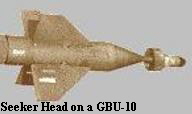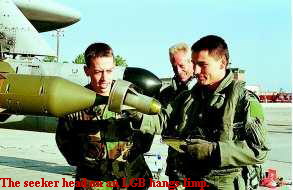|
|
 |
|
|
 |
 |
 |
 |
 |
|
"We didn't know enough about lasers at all ..." -- Weldon Word Although certainly not a new discovery to science by
1965, the laser was virgin territory for the TI engineers. At first, they didn't know how to read if the machine was on or off. It was a simple problem with a simple solution, Word
remembers. "We got this thing and we were out on the outskirts of Dallas on about a three story building. We were shooting the laser at a Plano, Texas water tower about a mile
away. That was the only thing sticking out of the ground. We didn't know anything about safety. We didn't know enough about lasers at all. We were using wet emulsion Polaroid film.
The only way we could tell the laser worked was to take the Polaroid film, hold it with your finger tips and stick it front of the laser. We knew it was on and working if it blew a hole through the
film about the size of a penny right through the film," Word recalls.
The laser may have presented a unique set of detection problems, but at least it was a tangible device. The
seeker was designed and built from a concept which had been drawn out on a sheet of paper. There was no such device. A challenge, the seeker was the part of the system the team had to develop on
their own. 
The engineers figured out that a silicon material could be used to detect the light, they fashioned a thin wafer of the silicon and
placed it in the front of the seeker. The material detected the laser light. The next challenge was the aerodynamics of the sensor. After running through a
few mathematical analog computer simulations on machines that required programming in terms of turning gears and cogs, TI aeronautical engineer Dick Johnson struck upon the
idea to use an aircraft probe. Johnson thought that a probe device, which is used to measure air flow around leading edges of aircraft, would work aerodynamically as a seeker.
"We struck on the idea of lets put the seeker in a Geanini Probe," Word said. "What that will do is put the seeker, the
instrument that is looking for the spot the instrument that is giving guidance directions." The probe resembled a badminton birdie, and from then on it was dubbed the "Birdie Head."
The engineers couldn't just slap the probe on the end of the bomb, and brand it a guided weapon, though. It had to be aerodynamic. There was no funding to test the aerodynamics
of the laser guided bomb shapes in a wind tunnel. A back yard swimming pool held the answer. Johnson made several scale models of the fat shaped World War II bombs and used
a swimming pool to test their aerodynamic wind flow.
"About a month into this, Dick came in with a little model he had made at home. It was about 10-inches long. We took
that model, went out to the swimming pool and dropped it. He had different size control surfaces and he was trying to get the dart to have stability with the smallest size fins we could
make. We had to get it under the wing of the airplane, and if you couldn't get it going outwards you had to go radially," Word recalls.
The lack of money in late 1965 also meant the team had to be creative in the test approach used at Eglin Air Force Base, Florida. With no funds for large data collection devices and
expensive machinery, the key word in the test program was "improvise," Nick Baker recalls.
"When we did the first tests, well, we didn't have enough
money to go put a nice telemetry system on the weapon. We had a high resistance tape recorder that you just screwed in the fuse well. That bomb would go down and burrow down
and it may go off to the side, and we had to find it to recover this tape recorder. It looked like we were digging up half the county down there to find the things. You had great big
cranes out there digging up all these holes to recover that data. You normally think of test programs with big telemetry systems, and we did not have a wealth of data. If you had to
stand out there for a week digging, then it was worthwhile to do that. You just had to have that information. No matter what the result was that created the hole in the ground, you
had to have the information to judge the performance of it."
Digging in the sand and clay of west Florida was worth the trouble to the TI team. Out of ten bombs tested on the
Florida ranges, eight were deemed a success, coming within thirty feet or closer to the target. The Air Force began combat trials of the bombs in 1968, and based on those, the
Paveway was redesigned and mated in the summer to the "slick" shaped or Mark-80 series of bombs. |
|
|
|
Continue to Usage |
|
 |
 |
|
The raw materials go boom The Mark-80 series bombs, which are the heart of an LGB, are still in use today. Developed in the 1950s, at the U.S. Navy's Weapons Development Center near
Ridgecrest, Calif. better known as China Lake, the Mark-80 series bombs are called "Low Drag, General Purpose," LDGP, bombs by the U.S. military because they have what is generally known as a slick
low drag shape. These bombs do not add too much drag to supersonic aircraft -- important when the fighter profession's motto is "Speed is Life."
The bombs were developed by Ed Heinemann, who
also designed and developed the Douglas A-4 "Skyhawk," because the "fat" or bulbous shaped bombs of World War II created huge amounts of drag when slung under the wing of a
fighter-bomber.
Heinemann set about to create a bomb which would not only glide through the air better but also be slimmer than the World War II era bombs. The Mark-80 series bombs are elongated with
thin cast steel walls which fragment easily and give the Mark-80s a bigger punch in terms of fragmentations. Explosives within the bomb is called "Tritonal 80/20" because it is a 80-percent TNT and
20-percent aluminum binder/inhibitor. This mix lessens the explosive power of the TNT but creates a bomb which is stable in storage which lends itself well to use aboard aircraft carriers.
The bombs are the Mk-82, 500-pound, Mk-83, 1000-pound and Mk-84 2,000
pound weapons. The Air Force prefers the Mk-82 and Mk-84 bombs, while the standard bomb of the U.S. Navy is the Mk-83.
Word and his Texas Instruments team started out with surplus World War II bombs
because it was an Air Force contract and the Air Force had resisted purchasing bomb shapes -- slick or otherwise -- made by the Navy. The blue suiters wanted to develop their own bombs.
"We
started with the old 750-pound bombs which were hard to control," said Word. " The Navy had the slick 1,000 Mark-80 series. There was a whole bunch of Mk-117 75-pounders and Mk-118 3,000 pounders left in the
arsenal from World War II. Well, here's that interservice rivalry again. The Air Force didn't want to use the Navy bomb shapes -- which were slicker and more aerodynamic. They wanted to go off and develop
themselves some more bombs. And DoD squashed that real quick. They said the Mark-80 series was going to be the standard bomb for all the services -- end of subject. That's why, about the time Paveway got
rolling we switched to the Mk-82 and the Mk-84 -- the 500-pounder and the 2000-pounder. Throughout Vietnam, we really built kits that were canards and control groups that were sized for the Mk-82 and the
Mk-84s, but in the beginning during the development phase our customer was the Air Force and we used those surplus bombs from World War II. "
Although the project name for the early laser guided bomb was Paveway I,
the Air Force called it the BOLT-117 (BOmb, Laser Terminal-117) and it consisted of a standard 750-pound bomb case with a KMU-342 laser guidance and control kit. Today, the Paveway II series uses the
MAU-169E/B guidance group and the Paveway III utilizes the vastly improved WGU-12B, -36A/B or -39/B guidance group. The difference between the first Paveways and the ones in use today are like the difference
between jet and prop driven fighters. The Paveway III is so sophisticated it can be tossed from almost 20 miles out and an autopilot will guide the bomb to its target. This allows the aircrews a greater
standoff range and the ability to avoid not only enemy guns and surface to air missiles but also gives them a chance to avoid detection all together.-- Shelby G. Spires |
|
|